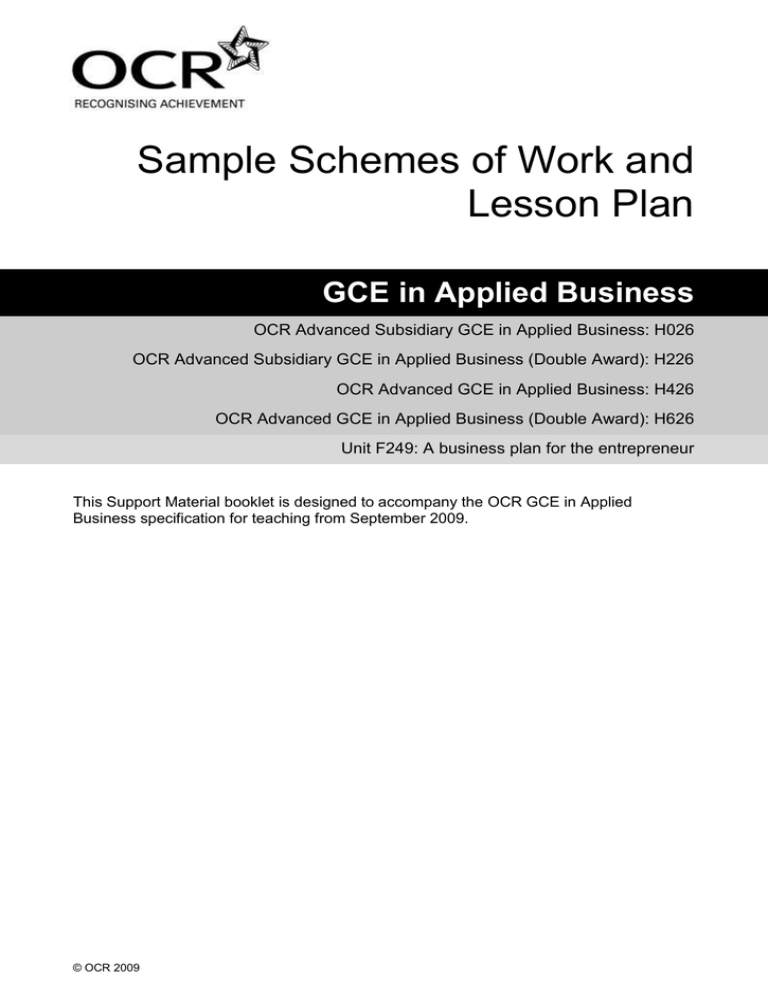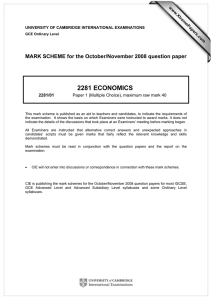Unit F249 - A business plan for an entrepreneur - Sample scheme of work and lesson plan (DOC, 431KB)
advertisement

Sample Schemes of Work and Lesson Plan GCE in Applied Business OCR Advanced Subsidiary GCE in Applied Business: H026 OCR Advanced Subsidiary GCE in Applied Business (Double Award): H226 OCR Advanced GCE in Applied Business: H426 OCR Advanced GCE in Applied Business (Double Award): H626 Unit F249: A business plan for the entrepreneur This Support Material booklet is designed to accompany the OCR GCE in Applied Business specification for teaching from September 2009. © OCR 2009 Contents Contents 2 Sample Scheme of Work: OCR GCE in Applied Business Unit F249: A business plan for the entrepreneur 4 Sample Lesson Plan: OCR GCE in Applied Business Unit F249: A business plan for the entrepreneur 8 2 of 8 GCE in Applied Business A Guided Tour through the Scheme of Work = Innovative Teaching Idea This icon is used to highlight exceptionally innovative ideas. = ICT Opportunity This icon is used to illustrate when an activity could be taught using ICT facilities. GCE in Applied Business 3 of 8 Sample GCE Scheme of Work OCR GCE in Applied Business Unit F249: A business plan for the entrepreneur Suggested teaching time 20 hours Topic outline Introduction to the research required Topic Suggested teaching and homework activities Suggested resources Points to note Specification - appropriate research for a business plan. Handout which includes the headings found within section ‘Business plan templates’ of the unit specification. It must be made clear to candidates that every statement or figure included in the business plan must be based on research. Research must be sufficiently rigorous to enable the candidate to produce a realistic and appropriate business plan. NB the layout the candidates finally use for their business plans must include all the headings found within the section ‘Information within a business plan’ of the unit specification. Candidates are required to justify their sales forecast figures and selling price. In order to justify sales they could observe the footfall for a similar business over a number of days at different times. The selling price could be justified through the calculation of mark-up or margin. Review of business plans What is primary research? = Innovative teaching idea 4 of 8 AO3 – Appropriate research for a business plan Go through the research requirements for the business plan. Emphasise that all statements made within the business plan must be supported by primary and secondary research. No ideas ‘plucked out of the air’. Candidates analyse at least two business plan templates using the handout. Candidates summarise their findings stating the layout they found most useful and the points they will incorporate within their own business plan. Homework - candidates collect a variety of questionnaires. Working in pairs candidates review the questionnaires they have collected. Candidates analyse what they think works well and the structure of the questions they consider to be less effective. Handout which has the four parts of the business plan down the side. Candidates can then consider the type of information they will need to research. Candidates need to make reference to the unit specification and consider how they will justify each of the bullet points found within = ICT opportunity GCE in Applied Business Sample GCE Scheme of Work OCR GCE in Applied Business Unit F249: A business plan for the entrepreneur Suggested teaching time 20 hours Topic outline Candidates conduct their primary research = Innovative teaching idea GCE in Applied Business Topic AO3 – Appropriate research for a business plan Suggested teaching and homework activities Still working in pairs students need to consider the information they need to find out for each part of the business plan marketing, finance, human resources and production. Use the handout to hep structure ideas. Candidates need to establish and justify who their target market will be - this could link to secondary research. Using the handout above design the questionnaire and/or focus group questions. Candidates trial their questionnaire on five people. Did the questions work? If not why not and how could they be modified? Modifications to questionnaire. Conduct primary research. Analyse results of primary research using a range of statistical techniques. Candidates summarise their findings, clearly explaining how these will impact on the Suggested resources Points to note these sections. For example, marketing what type of promotion would appear to potential customers? This will then link to secondary research - what is the cost of the promotion? Finance - how much would they normally pay for a similar product or service? How frequently do they purchase the product or service? AS Level for OCR Applied Business (Rob Dransfield and Dave Needham) pages 1921. 1st edition published 2005. AS Level for OCR Applied Business (Rob Dransfield and Dave Needham) pages 2931. 1st edition published 2005. If candidates wish to achieve mark band 3 they will have to use a range of statistical techniques. These are referenced in unit F240 Creating a marketing proposal. = ICT opportunity 5 of 8 Sample GCE Scheme of Work OCR GCE in Applied Business Unit F249: A business plan for the entrepreneur Suggested teaching time 20 hours Topic outline Topic AO3 – Appropriate research for a business plan Suggested teaching and homework activities Suggested resources Points to note development of the business plan. What is secondary research? = Innovative teaching idea 6 of 8 Class discussion about the type of secondary research candidates are required to carry out. Candidates work in pairs to compile a list of the type of secondary research they could carry out. Secondary research must again be linked to the justification of the four sections of the business plan. For example, establishment of price – what are competitors charging? Candidates draw up a plan of action for their secondary research. This should clearly state what they need to find out and how they will conduct this research. Handout on the different types of secondary research that candidates will need to carry out. This could be driven by the range of business enterprises selected by the group. = ICT opportunity GCE in Applied Business Sample GCE Scheme of Work OCR GCE in Applied Business Unit F249: A business plan for the entrepreneur Suggested teaching time 20 hours Topic outline Candidates conduct their secondary research Pulling all the research together = Innovative teaching idea GCE in Applied Business Topic AO3 – Appropriate research for a business plan Suggested teaching and homework activities Suggested resources Conduct secondary research. Access to the internet. Analyse results of secondary research. Candidates summarise their findings, clearly explaining how these will impact on the development of the business plan. Candidates complete an exercise using fictitious primary and secondary research findings. Candidates draw their own conclusions. These should include predicting sales volume, establishing sales price and total sales turnover. There should then be a linkage to purchases using mark up or margin. Exercise on how to summarise findings. This should include examples of fictitious primary and secondary results. Class discussion what did every one come up with? Were they all the same? What were the differences? Get individual candidates to justify their decisions. Candidates pull all their research together explaining how it has/will justify the decisions made within the business plan. Points to note It is imperative that there is a clear link between analysis of results and the statements made within the candidate’s business plan. If this is not evident the candidate will be unable to achieve much higher than mid to top end of mark band 2. = ICT opportunity 7 of 8 Sample GCE Lesson Plan OCR GCE in Applied Business Unit F249: A business plan for the entrepreneur Pulling the research together OCR recognises that the teaching of this qualification above will vary greatly from school to school and from teacher to teacher. With that in mind this lesson plan is offered, as a possible approach but will be subject to modifications by the individual teacher. Lesson length is assumed to be one hour. Learning Objectives for the Lesson Objective 1 Candidates draw conclusions from primary and secondary data to inform a strategy Objective 2 Candidates contribute to a class discussion Objective 3 Candidates are able to pull research together in order to justify a strategy Recap of Previous Experience and Prior Knowledge In the previous lesson candidates would have been conducting and analysing their secondary data. Content Time Content 20 minutes Candidates working on the exercise using supplied primary and secondary data to draw conclusions to inform a strategy. 20 minutes Class discussion – what conclusions did every one come up with? Were the figures the same? If not what were there reasons behind the differences? 10 minutes Candidates start pulling together their own primary and secondary data to inform the development of their business plan. Consolidation Time Content 10 minutes Question and answer session with the group to check that everyone is able to support all financial calculations with primary and secondary research. For example – what price are you going to charge? How have you justified that decision? How will you advertise your business – justification – what will it cost? 8 of 8 GCE in Applied Business



